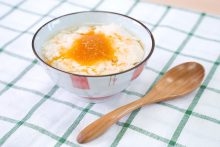The art of traditional Chinese desserts (糖水 tong-sui, literally “sugar water”) is about mastery of the most basic ingredients. Made with beans, nuts, or grains and sometimes with herbs, Chinese desserts has been an affordable comfort food for everyone.
(Personal) rule of thumb: always go with a hot one. I know, I know, summer in Hong Kong is scorching hot and there’s no better feeling than quenching your thirst with a cold bowl of dessert. Still, most of the time the hot version is just incomparably smoother and richer in taste.
Tofu pudding (豆腐花, dau-fu-fah or douhua in Mandarin speaking countries) is a shared recipe in China and across East Asia. Each region has its own variation—some are served savory with scallion and soy sauce; some adds chili pepper to it; in Hong Kong, the most common way of eating tofu pudding is with brown sugar and ginger syrup. Simple and sweet. In some soybean-specialized restaurants (豆品廠) though, you might see tofu pudding garnished with toppings like ginkgo and pearl barley. No worries they are equally delicious.

https://food.ulifestyle.com.hk/recipe/detail/2672753/%E8%B1%86%E8%85%90%E8%8A%B1%E9%A3%9F%E8%AD%9C-%E9%9B%BB%E9%A3%AF%E7%85%B2%E5%B0%B1%E6%95%B4%E5%88%B0-%E8%87%AA%E8%A3%BD%E8%B1%86%E8%85%90%E8%8A%B1%E9%A3%9F%E8%AD%9C-3%E6%AD%A5%E8%BC%95%E9%AC%86%E5%AE%8C%E6%88%90%E6%87%B6%E4%BA%BA%E4%B8%AD%E5%BC%8F%E7%94%9C%E5%93%81%7D
One big dessert family is the “pastes”. By grinding a chief ingredient into powder and cooking it with sugar and water, you get different kinds of thick soup. For example, we have black sesame paste (芝麻糊, ji-ma-woo), walnut paste (核桃糊, hut-tou-woo), and almond paste (杏仁糊, hung-yun-woo) from, well apparently, black sesame, walnut, and almond. I have also seen some shops doing house signature chestnut paste (栗子糊, leot-ji-woo) and cashew paste (腰果糊, yiu-gwoh-woo).
If you prefer a dessert not as thick and with something to chew, perhaps the followings will be more to your liking:
- Red bean soup (紅豆沙, hong-dau-sah) / green bean soup (綠豆沙, look-dau-sah);
- Sweet potato soup (蕃薯糖水, faan-shue-tong-sui);
- Papaya & snow fungus soup (木瓜雪耳糖水, mook-gwah-suet-yi-tong-sui);
- Tofu skin & pearl barley soup with hard-boiled egg (腐竹薏米雞蛋糖水, foo-jook-yi-mai-gai-daan-tong-sui).

Like some other Chinese food, certain desserts have a preferred consuming season and can be seen as remedies of sort. For instance, green bean soups are best eaten in summer for they are thought as dampness-relieving and detoxifying; papaya & snow fungus soups, on the other hand, are nourishing and soothing, something that warms you up in the cold winter. To tell you how Chinese culinary customs changes with seasons is another huge topic that requires another post, or even an entire Chinese medicine degree!
#chinesedessert #sweettooth #comfortfood #discoverhongkong #explorehongkong #foodiegram #hkfood #hkfoodporn #hkrestaurant #hongkongfoodie #hognkongtravel #ilovehongkong #visithongkong #hongkongfood


